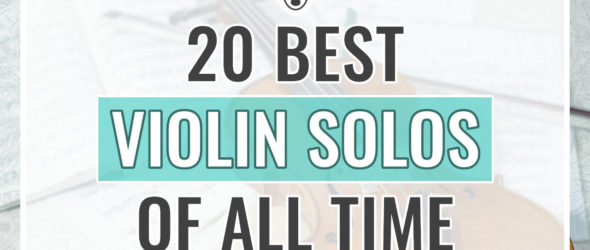There are so many great pieces of music written for the violin, but have you ever wondered what the best violin solo pieces to listen to are? Then you are at the right place!
You might be wondering why accompanied violin solos are even considered solos! This is because the violin part is the main voice, or the melody. The violinist plays the line that the listener focuses on. The other instrumentalists provide support through harmony, rhythms, and creating excitement.
In this article, we’ll be talking about accompanied violin solos, usually with orchestra or piano. If you’d like to check what are my best unaccompanied solos, check out this article.
Of course, there is never one “best violin solo” – there are hundreds of amazing violin solos written that all contributed to the rich history of violin playing.
Today let’s take a look at some of my personal favorite violin concertos, sonatas, showpieces, and other solos. Keep reading to learn about some incredible pieces of music!
Top 20 Violin Solos
- Beethoven – Kreutzer Violin Sonata
- Sibelius – Violin Concerto
- Biber – Mystery Sonatas
- Rimsky-Korsakov – Scheherazade
- Tchaikovsky – Violin Concerto
- Bruch – Violin Concerto No. 1
- Vivaldi – Four Seasons
- Mozart – Violin Concerto No. 5
- Barber – Violin Concerto
- Ravel – Tzigane
- Sarasate – Zigeunerweisen
- Bach – Chaconne and Prelude from 6 Sonatas and Partitas for Violin
- Handel – Violin Sonata No. 3
- Paganini – Caprice No. 24
- Pachelbel – Canon in D
- Horner – My Heart Will Go On
- John Williams – Schindler’s List
- Rimsky-Korsakov – Capriccio Espagnol
- Vaughan Williams – The Lark Ascending
Violin Solos: Concertos
Violin concertos are very popular pieces of classical music where the soloist can show off what they do best. There are almost always impressive technical passages and beautiful melodies involved. The violin is almost always the main event, but the melody usually weaves in and out through the violin solo and the orchestra, making for a beautiful musical conversation.
Vivaldi: The Four Seasons and Concerto in A minor RV 356
Antonio Vivaldi (1678-1741) wrote The Four Seasons, one of the most famous Baroque era violin concertos. Each concerto corresponds with a season, and Vivaldi also wrote a poem for each season. Click here to check out my video tutorial for Spring from the Four Seasons arranged for beginners, and here you can download the sheet music for an easy version of Spring, mvmt. 1 Allegro:
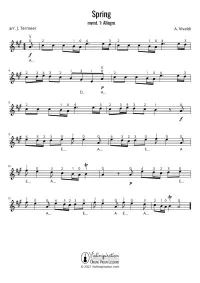
Spring, mvmt. 1: Allegro by A. Vivaldi
Free Violin Sheet Music
Mozart: Violin Concerto No. 5 in A Major “Turkish”, K. 219
Wolfgang Amadeus Mozart is the most famous composer from the Classical era. He was most well known for his operas, which are sometimes quoted in his violin concertos! Each of his five violin concertos is beautiful, but his final concerto, nicknamed “Turkish,” is the most elaborate.
Tchaikovsky: Violin Concerto in D Major, Op. 35
Tchaikovsky (1840-1893) is best known for his ballets. His only Violin Concerto in D Major also sounds pretty dance-like. Take a listen and see what you think! The concerto wasn’t well-received when it premiered, but now, it’s one of the most famous violin concertos.
Bruch: Violin Concerto No. 1 in G minor, Op. 26
Max Bruch (1838-1920) wrote his first violin concerto between 1866 and 1868, and it’s since become one of the most famous violin solos of all time. The first movement (“Vorspiel”) is an introduction, and the second movement is the bulk of the concerto. The third movement is a bright, energetic finale. Be sure to also listen to his Scottish Fantasy, which is another very famous violin solo!
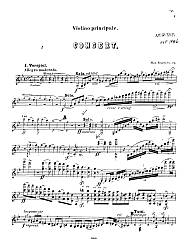
Bruch – Violin Concerto No. 1
Free Violin Sheet Music
Sibelius: Violin Concerto in D minor, Op. 47
Jean Sibelius, a Finnish composer during the late Romantic era, only composed one concerto. The Violin Concerto in D minor is luscious and sweeping, and there’s a giant cadenza in the middle of the first movement. Be sure to check out this fantastic performance by Hilary Hahn!
Barber: Violin Concerto, Op. 14
Samuel Barber, an American composer, wrote his Violin Concerto in 1939. He was paid to write it for a businessman’s son who played violin, but, after sending his patron the draft of the first movement, was told that the piece was too simple. Barber then wrote the third movement and was told it was too difficult. Despite being “simple,” this concerto is full of emotion, and really shows off the range of the instrument.
Violin Solos: Showpieces
These pieces of classical music include lots of technical passages and recognizable melodies. Many showpieces were written by virtuoso violinists to perform on tour and impress their audiences.
Ravel: Tzigane
French composer Maurice Ravel wrote Tzigane for the Hungarian great-niece of famous violinist Joseph Joachim. It was originally written for violin and piano (with a tone-changing attachment called a luthéal), but Ravel also orchestrated it. Tzigane translates directly to “gypsy,” but the piece doesn’t use any traditional Roma melodies. Instead, Ravel was inspired by French gypsies.
Sarasate: Zigeunerweisen, Op. 20
Zigeunerweisen was composed by famous violinist Pablo de Sarasate in 1878. The title of the piece means “Gypsy Airs,” and again, the music was not inspired by the Romani people. Instead, the sound was based on Hungarian folk music.
Paganini: Caprice No. 24 in A Major
Niccolò Paganini was the biggest violin star of the Romantic period. His technique was so flawless, that he advanced violin music through both his playing and through his compositions. He wrote 24 Caprices for Solo Violin. During his lifetime, he was the one who performed them the most, since the techniques he wrote were so incredibly difficult.
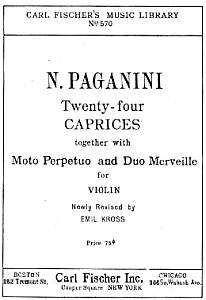
24 Caprices by Paganini
Free Violin Sheet Music
Vaughan Williams: The Lark Ascending
Ralph Vaughan Williams, an English composer, wrote The Lark Ascending for violin and piano in 1914. It wasn’t until 1920 that it was premiered, and Vaughan Williams didn’t arrange it for violin and orchestra until after World War I. The piece is based on the poem The Lark Ascending, written by George Meredith in 1881.
Violin Solos: Sonatas
In the Classical period, composers organized the Sonata form to what we recognize today. Sonatas are generally three movements long and last under 40 minutes.
Biber: Mystery Sonatas
The Mystery Sonatas (also called the Rosary Sonatas) is a group of 15 sonatas for violin with a final passacaglia at the end. These were composed by Heinrich Ignaz Franz Biber around 1676, but only became widely known when the work was published in the 20th century. Some of the sonatas are for solo violin, others are accompanied by basso continue, and others use scordatura. This is when the musician tunes their strings to different pitches!
Bach: Chaconne from Sonatas and Partitas for Solo Violin (BWV 1001-1006)
J. S. Bach wrote so much music for string instruments, but one of his most famous pieces is the Chaconne from Partita No. 2 in D minor for Solo Violin. Even though the Sonatas and Partitas were completed by 1720, they weren’t published until 1802. It wasn’t even popular until violinist Joseph Joachim began performing it in the late 1800s.
Handel: Violin Sonata No. 3 in F Major
The first movement of Handel’s 3rd Violin Sonata is a great option for intermediate students to learn. This piece is a great way to practice Baroque era ornamentation! This sonata was originally written for violin and basso continuo. It’s now debated as to whether or not Handel was actually the one who wrote it. No matter who composed it, this is a great piece to learn!
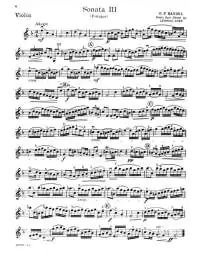
Violin Sonata No. 3 in F Major by Händel
Free Violin Sheet Music
Beethoven: Violin Sonata No. 9, “Kreutzer”
Out of Beethoven’s 10 violin sonatas, Violin Sonata No. 9, nicknamed “Kreutzer” is one of the most famous. It’s emotional, challenging, and extremely long for a sonata. The Sonata was given its nickname because Beethoven dedicated the piece to Rodolphe Kreutzer, a famous violinist who wrote popular etudes. Kreutzer ended up hating the sonata, and never played it.
Orchestral Solos
There’s a wide range of violin solos within symphonies and other orchestral works. The concertmaster position is a big role, including playing a lot of solos! The two I’m sharing with you today were both written by Rimsky-Korsakov. They’re both beautiful. Let me know if you like them as well in the comments below!
Rimsky-Korsakov: Scheherazade, Op. 35
Scheherazade is a symphonic suite written by Russian composer Rimsky-Korsakov, based on the story of One Thousand and One Nights. The piece is made up of four movements, telling the story through music. There are two big violin solos in Scheherazade: one in the first movement, and another similar one in the fourth movement. This excerpt comes up often in concertmaster auditions for orchestras! If you have time, listen to the whole piece. It’s a magical experience!
Rimsky-Korsakov: Capriccio Espagnol, Op. 34
Another big violin solo in an orchestral piece happens in Capriccio Espagnol, also written by Rimsky-Korsakov. It’s so violin-heavy that he’d intended it to write the piece for solo violin with orchestra!
Violin in Pop Culture
The violin has always been a very popular instrument and is heard all over the world on many different occasions. We now hear the violin in movies, pop music, tv shows, and weddings, among other places. Here are a few pieces you may have heard violin out and about.
Williams: Theme from Schindler’s List
One of the most popular violin solos in pop culture is from the soundtrack of the 1993 movie Schindler’s List. The iconic theme was written by John Williams and performed by Itzhak Perlman. Itzhak Perlman still performs the theme regularly at classical music concerts!
My Heart Will Go On from Titanic
Another iconic 90’s movie theme includes violin solos! This pop song, sung by Celine Dion, is iconic, and not too difficult to learn. Watch a tutorial to learn My Heart Will Go On in my Video Lessons Library!
Pachelbel: Canon in D
Johan Pachelbel’s Canon in D is one of the most popular classical violin solos. Even though it’s been arranged for almost every group of instruments imaginable, most people recognize the melody as a violin solo. Want to learn how to play Canon in D? Click here for the practice tips! Below you can download free violin sheet music with my recommended fingering:
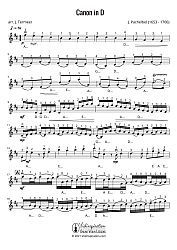
Pachelbel’s Canon in D
Free Violin Sheet Music
FAQ
What is the best violin solo?
The best violin solo is very subjective! A few great choices are Sonatas and Partitas for Violin by J.S. Bach, Bruch’s Violin Concerto in G minor, Beethoven’s Violin Sonata No. 9, and Tchaikovsky’s Violin Concerto. Take a listen to these violin solos and see which one you like the best!
What is the best violin solo for a beginner?
Ode to Joy by Beethoven is a great violin solo for a beginner! Many people can recognize this song by ear, and it sounds really impressive. Ode to Joy can be played mostly on just the D string in the first position.
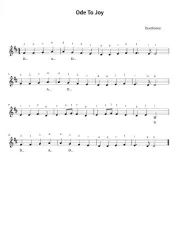
Ode to Joy by Ludwig van Beethoven
Free Violin Sheet Music
What is the most popular violin song?
One of the most popular violin songs is J.S. Bach’s Chaconne from his Partita No. 2 for Violin. It’s one of the most performed violin works and is easily recognizable. Most famous violinists have performed this piece since it’s unaccompanied – no one else plays with the violinist.
What are violin solos called?
There are a few different types of violin solos. The first type is a concerto. This is a piece of music written for solo violin with an orchestra. Next is a showpiece, usually for violin solo with orchestral or piano accompaniment. Another type of violin solo is the sonata. These are usually performed unaccompanied, or with piano. There are also solos within bigger pieces for the orchestra, like symphonies or symphonic poems. Lastly, there are many violin solos in pop culture!
A concerto is written for a solo instrument with orchestral accompaniment. These pieces are made for the soloist to show off their talents. There’s almost always a cadenza, where the soloist can really impress the audience.
A showpiece is even flashier than a concerto and is written for either violin with piano, or violin with orchestra. Showpieces are the most impressive way for a violinist to showcase their abilities.
Sonatas can be written for violin alone, violin with piano, or violin with another instrument. Sonatas are generally a little more laid back than concertos and showpieces, and have fewer technical passages.
Orchestral solos are common for first violinists, and the excerpts will generally pop up on concertmaster auditions.
Violin solos are also frequent in pop culture, in movies, pop songs, and TV shows.
What is the hardest violin solo piece?
Paganini’s 24 Caprices for Violin are some of the hardest violin solo pieces. When he wrote them, Paganini was one of the only violinists actually able to play them! These violin pieces require many advanced techniques like left-hand pizzicato, very fast notes, and artificial harmonics.
